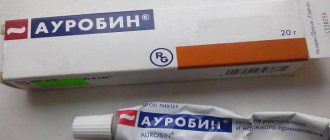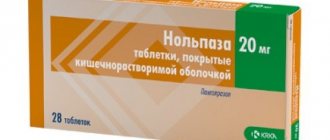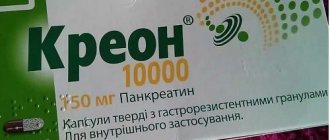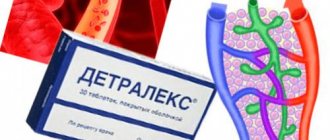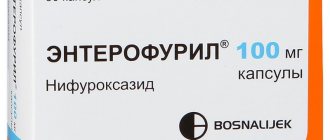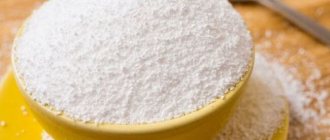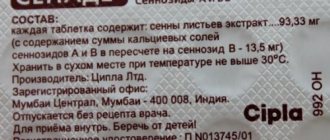Among antiulcer drugs used in the treatment of gastritis and other gastric diseases, Pariet is very popular. The instructions for use included with the drug contain all the information necessary to understand its effect on the body.
Before purchasing a drug, it is important to understand the main nuances and consider possible analogues that will help you decide on the final choice. Preliminary familiarization with the instructions will help you set priorities and make the right choice.
Release form and composition
Pariet tablets are covered with a light yellow coating that dissolves in the intestines. The round shape of the drug has a specific marking that deciphers the corresponding dosages:
- E241, characteristic of 10 mg of active substance,
- E243, indicating a dosage of 20 mg.
Aluminum blisters containing 7, 14 or 28 tablets are placed in cardboard packaging.
The active substance is rabeprazole sodium, and auxiliary:
- magnesium oxide – 44.7 mg,
- mannitol – 26 mg,
- weakly substituted hyprolose – 13 mg and hyprolose (E463) – 4 mg,
- hypromellose phthalate – 8.5g,
- magnesium stearate – 1 mg,
- monoglyceride – 0.85 mg,
- talc – 0.8 mg,
- ethylcellulose – 0.7 mg,
- titanium dioxide – 0.43 mg,
- red iron oxide – 0.02 mg,
- carnauba wax – 0.0015 mg,
- edible gray ink.
Please note that these figures are for 10 mg tablets. With increasing dosage, the amount of substances contained increases. It is also worth noting that in 20 mg tablets, the edible ink has a red tint, and the iron oxide is yellow.
Pariet manufacturers
Information about the manufacturer of Pariet indicates:
- RF (“Johnson&Johnson”),
- Switzerland (“CILAG AG”),
- Japan (“EISAI Co.”).
Despite the options offered, Pariet production is concentrated exclusively in Japan. A Russian company that has a registration certificate carries out quality control and receives incoming claims. The Swedes are solely responsible for the production of packaging.
pharmachologic effect
Pariet is an antiulcer inhibitor drug that reduces gastric secretion of hydrochloric acid. The final effectiveness is determined by the dose taken.
Pharmacokinetics and pharmacodynamics
Pharmacokinetic properties of Pariet:
- Absorption. After entering the intestines, the medicine begins to be intensively absorbed. After 3.5 hours, the active substance entering the plasma reaches its maximum concentration. In this case, the time of administration does not affect the speed and efficiency of absorption.
- Distribution. The degree of binding of the active substance to blood plasma proteins is 97%, showing the high effectiveness of Pariet.
- Removal . Rabeprazole is excreted from the body by 99.8%: 90% in urine, and 9.8% in feces. In older people suffering from slow metabolism, the substance is eliminated more slowly, but without consequences.
Pharmacodynamic properties of Parit:
- Mechanism of action. Rabeprazole does not have anticholinergic properties. It successfully suppresses the secretory function of the stomach, regardless of the source of influence (inhibitory - basal, excitatory - stimulated). Efficacy depends on the dose of the active substance
- Antisecretory action. When taken orally with a dosage of 20 mg, the antisecretory effect is observed within 60 minutes, and its maximum is achieved within 3-4 hours. Stability in the inhibition of gastric secretion is achieved after 3 days of use of the drug. After discontinuation of the drug, the previous activity of gastric secretions returns after 2 or 3 days.
- Effect on gastrin. The hormone exceeds the norm for 0.5-2 months under treatment with a dosage of 20 mg. After stopping the use of Pariet, gastrin returns to its original value within 14 days.
- Effect on enterochromaffin-like cells. Gastric biopsies taken from 500 subjects showed low endocrine cell hyperplasia excluding adenomatosis and carcinoids.
- Other effects. No effects on the respiratory, cardiovascular or central nervous systems were detected.
Pariet
A drug that reduces the secretion of gastric glands - proton pump inhibitor
Mechanism of action
Rabeprazole sodium belongs to the class of antisecretory substances, benzimidazole derivatives. Rabeprazole sodium suppresses gastric acid secretion by specifically inhibiting H+/K+ ATPase on the secretory surface of gastric parietal cells. H+/K+ATPase is a protein complex that functions as a proton pump, thus rabeprazole sodium is an inhibitor of the proton pump in the stomach and blocks the final stage of acid production. This effect is dose-dependent and leads to suppression of both basal and stimulated acid secretion, regardless of the stimulus. Rabeprazole sodium does not have anticholinergic properties.
Antisecretory action
After oral administration of 20 mg of rabeprazole sodium, the antisecretory effect develops within an hour. Inhibition of basal and stimulated acid secretion 23 hours after taking the first dose of rabeprazole sodium is 69% and 82%, respectively, and lasts up to 48 hours. This duration of pharmacodynamic action far exceeds that predicted by the half-life (approximately one hour). This effect can be explained by prolonged binding of the drug to the H+/K+ ATPase of gastric parietal cells. The magnitude of the inhibitory effect of rabeprazole sodium on acid secretion reaches a plateau after three days of taking rabeprazole sodium. When you stop taking it, secretory activity is restored within 1-2 days.
Effect on plasma gastrin levels
In clinical studies, patients took 10 or 20 mg of rabeprazole sodium daily for treatment durations of up to 43 months. Plasma gastrin levels were elevated in the first 2–8 weeks, reflecting an inhibitory effect on acid secretion. Gastrin concentrations returned to baseline levels usually within 1-2 weeks after cessation of treatment.
Effect on enterochromaffin-like cells
In a study of human gastric biopsy specimens from the antrum and fundus of the stomach of 500 patients treated with rabeprazole sodium or a comparator for 8 weeks, persistent changes in the morphological structure of enterochromaffin-like cells, severity of gastritis, incidence of atrophic gastritis, intestinal metaplasia, or prevalence of Helicobacter infection pylori were not detected.
In a study of more than 400 patients treated with rabeprazole sodium (10 mg/day or 20 mg/day) for up to 1 year, the incidence of hyperplasia was low and comparable to that of omeprazole (20 mg/kg). There have been no reported cases of adenomatous changes or carcinoid tumors observed in rats.
Other effects
Systemic effects of rabeprazole sodium on the central nervous system, cardiovascular or respiratory systems have not currently been detected. It has been shown that rabeprazole sodium, when taken orally at a dose of 20 mg for 2 weeks, has no effect on thyroid function, carbohydrate metabolism, the level of parathyroid hormone in the blood, as well as on the levels of cortisol, estrogens, testosterone, prolactin, glucagon, follicle-stimulating hormone (FSH), luteinizing hormone (LH), renin, aldosterone and growth hormone.
Pharmacokinetics
Absorption
Rabeprazole is rapidly absorbed from the intestine and peak plasma concentrations are achieved approximately 3.5 hours after administration of a 20 mg dose. Changes in peak plasma concentrations (Cmax) and area under the concentration-time curve (AUC) of rabeprazole are linear over the dose range from 10 to 40 mg. Absolute bioavailability after oral administration of 20 mg (compared to intravenous administration) is approximately 52%. In addition, bioavailability does not change with repeated dosing of rabeprazole. In healthy volunteers, T1/2 from plasma is about 1 hour (varying from 0.7 to 1.5 hours), and the total clearance is 3.8 ml/min/kg. In patients with chronic liver damage, AUC is doubled compared to healthy volunteers, indicating a decrease in first-pass metabolism, and T1/2 from plasma is increased by 2-3 times. Neither the time of taking the drug during the day nor antacids affect the absorption of rabeprazole. Taking the drug with fatty foods slows down the absorption of rabeprazole by 4 hours or more, but neither Cmax nor the degree of absorption changes.
Distribution
In humans, the degree of binding of rabeprazole to plasma proteins is about 97%.
Metabolism and excretion
In healthy people
After taking a single oral dose of 20 mg of 14C-labeled rabeprazole sodium, no unchanged drug was found in the urine. About 90% of rabeprazole is excreted in the urine mainly in the form of two metabolites: a conjugate of mercapturic acid (M5) and carboxylic acid (M6), as well as in the form of two unknown metabolites identified during toxicological analysis. The remainder of the rabeprazole sodium taken is excreted in the feces.
The total elimination is 99.8%. These data indicate a small excretion of rabeprazole sodium metabolites in bile. The main metabolite is thioester (M1). The only active metabolite is desmethyl (M3), but this was observed at low concentrations in only one study participant after taking 80 mg rabeprazole.
End stage renal failure
In patients with stable end-stage renal disease who require maintenance hemodialysis (creatinine clearance <5 ml/min/1.73 m2), the elimination of rabeprazole sodium is similar to that of healthy volunteers. AUC and Cmax in these patients were approximately 35% lower than in healthy volunteers. On average, T1/2 of rabeprazole was 0.82 hours in healthy volunteers, 0.95 hours in patients during hemodialysis and 3.6 hours after hemodialysis. Clearance of the drug in patients with kidney disease requiring hemodialysis was approximately twice as high as in healthy volunteers.
Chronic compensated cirrhosis
Patients with chronic compensated liver cirrhosis tolerate rabeprazole sodium 20 mg once daily, although AUC is doubled and Cmax is increased by 50% compared to sex-matched healthy volunteers.
Elderly patients
In elderly patients, the elimination of rabeprazole is somewhat slower. After 7 days of rabeprazole 20 mg per day in elderly subjects, the AUC was approximately twice as high and the Cmax was increased by 60% compared to young healthy volunteers. However, there were no signs of accumulation of rabeprazole.
CYP2C19 polymorphism
In patients with slow metabolism of CYP2C19, after 7 days of taking rabeprazole at a dose of 20 mg per day, AUC increases by 1.9 times, and T1/2 by 1.6 times compared with the same parameters in “rapid metabolizers”, while increasing by 40% .
Indications for use
Pariet with a dosage of 10 mg is indicated for use for:
- elimination of symptoms caused by gastroesophageal reflux disease (GERD),
- eliminating the effects of excessive stomach acidity, including heartburn, sour belching and a sour taste inside the mouth.
Thus, the minimum dosage of Pariet is designed solely to suppress symptoms and is not suitable for treatment
The main indications for the use of Pariet 20 mg include:
- a peptic ulcer that affects the duodenum and occurs in an acute form,
- erosive and non-erosive gastroesophageal reflux disease, treated in remission,
- ulcerative gastric disease, occurring in acute form,
- peptic ulcer of the anastomosis,
- conditions characterized by a pathological condition of the stomach associated with hypersecretion, including Zollinger-Ellison syndrome,
- chronic gastritis,
- eradication therapy for Helicobacter pylori,
- hypersecretion of hydrochloric acid of an idiopathic nature,
- necrosis of the mucous membranes of the digestive tract.
What is it prescribed for?
The drug is prescribed for the symptomatic treatment of GERD, the treatment of acid-related diseases and the prevention of their exacerbations. “Pariet” helps with stomach pain, heartburn, reflux into the esophagus, and promotes the healing of damage in conditions such as:
- peptic ulcer of the stomach and duodenum;
- erosive and non-erosive forms of GERD;
- Zollinger-Ellison syndrome;
- ulcerative lesions associated with Helicobacter;
- erosive reflux esophagitis;
- idiopathic HCl secretion.
Contraindications
Available contraindications:
- pregnancy,
- age less than 12 years (for a drug with 20 mg of rabeprazole) or less than 18 years (for a drug with 10 mg of active substance),
- lactation period,
- the presence of hypersensitivity to the main components.
Please note that there are no contraindications to drinking alcohol, but doctors still recommend excluding it during treatment.
Most of the considered contraindications are absolute, that is, they exclude the use of Pariet under any circumstances.
Relative contraindications, such as childhood and renal or liver failure, allow the use of Pariet, but under the strict supervision of the attending physician.
Overdose
Rapid metabolism and elimination of the drug from the body minimizes the possibility of overdose. Even a single dose of 180 mg of the drug in the treatment of Zollinger-Ellison syndrome did not provoke the occurrence of symptoms that could be associated with excess dosage. There is no specific antidote to Pariet, therefore, if an overdose does occur, then symptomatic treatment is necessary.
Directions for use and dosage regimen
The tablets are taken at a convenient time of day and do not depend on food intake. Pariet is swallowed whole without preliminary crushing or chewing.
The dosage differs depending on the amount of active substance:
- 10 mg – 1 time per day from 3 to 14 days. If your health has not changed on day 4, you should consult a gastroenterologist. A course of treatment longer than 2 weeks is prescribed only on the recommendation of the attending physician.
- 20 mg - these tablets can only be purchased at a pharmacy with a prescription. The dosage regimen is determined solely by the doctor and depends on the concomitant disease.
Please note that despite the effectiveness of taking tablets at any time of the day, doctors recommend taking them in the morning. This regimen of use allows you to relieve unpleasant symptoms and prolong the activity of Pariet for the remaining time.
For gastric ulcers in the acute stage and anastomotic ulcers
1 tablet of 20 mg daily for 1.5 months (6 weeks). As a rule, after the designated time, a positive result is observed, leading to recovery. If there is no reaction, the medication is extended for another 1.5 months.
With duodenal ulcer in the acute stage
1 tablet of 20 mg daily for 0.5-1 months (2-4 weeks) . If there is no reaction, the medication is extended for another month.
In the treatment of erosive gastroesophageal reflux disease (GERD) or reflux esophagitis
1 tablet of 20 mg daily for 1-2 months (4-8 weeks). If there is no reaction, the medication is extended for another 2 months.
For maintenance therapy of gastroesophageal reflux disease (GERD)
1 tablet of 20 mg is taken daily , and the duration of the therapeutic course depends entirely on the patient’s well-being.
For non-erosive gastroesophageal reflux disease (NERD) without esophagitis
1 tablet of 20 mg daily for a month (4 weeks). If symptoms persist, it is recommended to undergo additional examination. After the symptoms disappear, Pariet is taken in the same dosage as required to avoid relapses.
For the treatment of Zollinger-Elison syndrome and other conditions characterized by pathological hypersecretion
The dosage is individual.
- The starting dose is 60 mg, that is, 3 tablets of 20 mg taken daily.
- The amount of Pariet is gradually increased to 100 mg (5 tablets), taken once a day, or divided into 2 daily doses of 60 mg.
- The duration of the therapeutic course is influenced by clinical need, extending treatment to 1 year.
For eradication of Helicobacter pylori
2 tablets of 20 mg daily for a week. The regimen for using Pariet is determined by the antibiotics used.
Pariet - instructions for use
Pariet is available in two doses - 10 mg and 20 mg in a package of 14 or 28 tablets.
In the stage of exacerbation of peptic ulcer and GERD, the therapeutic dose is 20 mg for 1-1.5 months. For maintenance and systematic treatment of GERD, 10 mg of Pariet for one month is sufficient.
To eliminate heartburn or sour belching, or for stomach pain, take 10 mg of the medicine once a day for no longer than two weeks without consulting a doctor. If the symptoms do not go away, an examination is necessary.
For pathologies characterized by hypersecretion of hydrochloric acid, the dose of Pariet is started at 60 mg and increased to 100 mg, taken once or twice a day.
For gastritis or peptic ulcer of the duodenum, aggravated by the gastric bacterium Helicobacter pylori, the doctor selects a comprehensive regimen with antibacterial agents.
Pariet 20 mg 28 pcs. Sold by prescription, 10 mg is available freely.
Side effects
Side effects caused by the use of Pariet are characterized by a low frequency of occurrence. For most patients, Pariet is completely safe and is not accompanied by complications from the body.
However, even if adverse reactions occur, the body does not cause significant discomfort.
Depending on the relevant system or organ, the following disorders are observed when using Pariet, regardless of dosage:
- The hematopoietic and lymphatic systems are rarely affected: leukopenia, neutropenia, thrombocytopenia.
- Central nervous system – asthenia, drowsiness, headaches, insomnia, dizziness.
- The liver (hepatobiliary system) is rarely (subject to prolonged use of Pariet) affected by: encephalopathy, drug-induced hepatitis, jaundice.
- The skin is affected by: urticaria and bullous lesions (rarely), toxic epidermal necrolysis, Stevens-Johnson syndrome and erythema multiforme (very rarely).
- The reproductive system is very rarely affected by gynecomastia.
- The immune system is rarely affected by allergic reactions.
- Metabolism is rarely affected by hypomagnesemia.
- The urinary system and kidneys are very rarely affected by interstitial nephritis.
- The muscular and skeletal systems are rarely affected: myalgia, arthralgia.
- The digestive system is rarely affected: anorexia, abdominal pain, dry mouth, vomiting, diarrhea, constipation, nausea, flatulence.
All reactions are rare or very rare, which is characterized by 1 case in 1001-10000 patients or 1 case in 10001 or more, respectively.
It is worth noting that post-marketing studies have revealed the possibility of an increased risk of fractures and osteoporosis associated with the leaching of calcium from the body when using Pariet.
Of the available side effects, the greatest danger is hypomagnesemia, leading to arrhythmia and convulsions due to the reduced amount of magnesium in the blood. In this regard, additional intake of magnesium is recommended, especially if the use of Pariet exceeds 3 months.
Side effects
Like many other medications, Heparin sometimes leads to side effects. These include the following conditions:
- changes in taste and loss of appetite;
- diarrhea;
- allergic manifestations in the form of urticaria, itching, irritability of the dermis;
- bronchospasms are rarely diagnosed;
- hematomas and bleeding at injection sites;
- pathological decrease in platelet concentration in the blood.
MORE ABOUT: Where to find money for cancer treatment - Social assistance
With long-term treatment with the drug in question, cases of the development of osteoporosis and spontaneous fractures against its background have been recorded.
To prevent the conditions described above, you should refrain from self-medication and use the medicine only as prescribed by a specialist. This will help achieve an optimal therapeutic effect and avoid complications.
Use during pregnancy and lactation
The lactation period and pregnancy are the main contraindications for the use of Pariet.
No direct effect on possible defects in fetal development or female fertility was found.
Experiments on rabbits and rats participating in drug studies showed the ability of Pariet to penetrate the uteroplacental barrier and established the presence of rabeprazole in breast milk.
In this regard, pregnant and lactating women are advised to temporarily stop taking the medicine.
Pariet can be authorized by a doctor in a situation where the positive effectiveness of the drug expected from the maternal side exceeds the possible harm to the fetus.
Reviews
2/3 of the reviews about this medicine are positive and only 1/3 are negative. Positive reviews note the high effectiveness of the drug, because No reappearance of symptoms was recorded after taking the medication.
In addition, people note that Pariet has minor or no side effects. This medicine has a high cost, so it becomes inaccessible to some segments of the population.
Negative reviews are usually associated with side effects that people have a very hard time with. As people's conditions worsened, they left negative reviews. There are practically no reviews on the Internet that the medicine turned out to be useless.
Application for children
Pariet is approved for use in children 12 years of age and older for the short-term treatment of GERD.
The dosage is 1 tablet of 20 mg daily for 2 months.- The regimen for taking Pariet is determined by antibiotics used in parallel. Appropriate studies have been conducted to confirm the effectiveness and safety of therapy.
- The use of Pariet in children under 12 years of age or for other indications is not allowed due to the lack of reliable data proving that such treatment can be effective and safe.
special instructions
During short-term therapy, which involves getting rid of the main symptoms of NERD and GERD, the patient is recommended to consult a doctor if:
- manifestations of anemia, swallowing disorders, persistent or bloody vomiting, or with the contents of the epigastric region, jaundice, unintentional weight loss, bleeding in the gastrointestinal tract, painful sensations when swallowing, gastric ulcers or a history of gastric surgery, etc.,
- changes in existing symptoms or the appearance of new ones over the age of 55 years,
- use of medications that relieve digestive system disorders or heartburn symptoms for more than 1 month.
The simultaneous use of Pariet with drugs that reduce acidity is prohibited:
- proton pump inhibitors (PPIs),
- blockers of histamine H2 receptors.
It is important to notify your doctor about your scheduled endoscopic examination before starting to use Pariet.
A urea breath test also rules out the drug.
During therapy using Pariet, it is recommended to avoid fried, spicy, fatty foods and spices.
Regardless of the prescribed dosage, before starting treatment, it is necessary to be examined for the presence of a malignant neoplasm in the stomach, since Pariet can mask oncological symptoms, which will interfere with timely diagnosis.
Hypomagnesemia
Cases of asymptomatic and symptomatic hypomagnesemia in patients taking PPIs were recorded no earlier than after 3 months. As a rule, such a problem arose only after 1 year of constant use of Pariet.
Serious side effects include:
- seizures,
- arrhythmias,
- tetany.
Subsequent treatment included the use of magnesium supplements and discontinuation of inhibitor-based therapy. In this regard, when taking diuretics or digoxin simultaneously in patients with a long therapeutic course, it is recommended to monitor magnesium concentrations before and during treatment.
Bone fractures
Data obtained from preliminary trials indicate the possible occurrence of fractures of the hips, wrists or spine in osteoporotic patients due to washed-out calcium.
An increased risk of a possible fracture was recorded in subjects taking high doses of Pariet for a duration exceeding 1 year.
Concomitant use of rabeprazole with methotrexate
Experiments have proven an increase in the amount of methotrexate and (or) its metabolite hydroxymethotrexate with parallel administration of rabeprazole.
An increase in half-life (T1/2) can provoke antimetabolite toxicity. Please note that this rule is only true if you are taking increased doses of methotrexate.
If an increased dosage of methotrexate is indicated, it is recommended to temporarily discontinue PPI therapy.
Clostridium difficile
The use of Pariet increases the possibility of gastrointestinal infections, including anaerobic gram-positive bacteria (clostridium difficile).
In case of illness (colitis), complete discontinuation of the drug is recommended.
PARIETE: reviews
I don’t remember at all how it all started, I only remember the pain in the upper abdomen, which has not gone away for a week. I need to see a doctor. Hands to feet and here I am with him. A bunch of tests were ordered (later it turned out that half of them were unnecessary). I was checked for all types of hepatitis, AIDS, blood tests for everything possible, a gastropanel, gastroscopy with a biopsy for Helicobacter pylori, etc. I spent about 20 thousand (!!!) on this whole thing, gave it up and cried, as they say. I was diagnosed with sluggish pancreatitis, gastritis and duodenitis and some other delights in the form of non-functioning valves that should close after eating and not release the contents of the stomach, even if you walk on your hands; throwing bile and acid where it is not needed; Helicobacter pylori. Treatment: Maalox, Creon and PARIET 2 weeks, ...read more
after - anti-Helicobacter therapy (2 antibiotics and PARITE) What we have: Pariet is terribly expensive, I was treated for 2 weeks, on Monday I had to see a doctor, on Friday I had a headache and it hurt all weekend. Out of habit, I took Spazgan tablets. And the pain, which had not bothered me for a long time, thanks to treatment, returned with renewed vigor. I'm running to the doctor. Result: because of the spasgan, all treatment was in vain! Let's start all over again! Heck, am I printing money? Okay, health is more important. I’ve been taking Maalox, Creon and PARIET for two weeks again. Everything passes (hurray!). On Monday we begin killing Helicobacter. Let me clarify a little: We become infected with Helicobacter in childhood, when we put our dirty hands in our mouths and sit on neighboring pots. Almost our entire population has it, and even if you cure it, you will become infected with it again. And he is treated with a loading dose of two antibiotics (clacid and flemoxin) + pariet. The doctor insisted that I would only get it if I stuck my tongue in someone’s stomach or breathed over someone’s vomit. The treatment regimen is standard. I buy Klacid, Flemoxin and PARIET. On Monday at 6:30 I take my first dose and go to work. By 8 I'm already feeling bad. I call an ambulance, there is a not particularly sane woman, she injects me with a noshpa and lets me go in peace. I’m going to the clinic, but a different one and to a different doctor. Now a diagram from the second doctor with whom I am now being treated: it makes sense to treat Helicobacter only if there is an erosion or ulcer. Because we will become infected with it again, and antibiotics are not vitamins, the harm from them is very high and the consequences can be disastrous. Since anti-Helicobacter therapy did not work out for me due to an acute negative reaction, I am prescribed another treatment. Treatment: PARIET, mezim, duspatalin, after duspatalin de-nol. Treatment is aimed at restoring the stomach, and not at killing Helicobacter. Diet: you can’t eat rich, fried, fatty, mushrooms, spicy, smoked, alcohol, strong tea and coffee, all sorts of nasty things like chips and soda. I had to write so much so that I could understand in what cases PARIET is prescribed. It normalizes the acidity of the stomach, or rather reduces the production of acid, which destroys the stomach in those places where there is no longer a protective layer due to the action of Helicobacter. Helicobacter loves acid in our stomach, in fact this is its habitat, it (he) destroys the protective layer covering our stomach and the acid begins to corrode the walls. If you have a stomach ache, I advise you to check your gall bladder, liver and pancreas. Because, usually, everything suffers together, it is a single digestive system. In addition to my sick stomach, I have sluggish pancreatitis and problems with the gall bladder. Pancreatitis due to junk food, and gall problems due to infrequent nutrition. So, when you are diagnosed with gastritis, check the neighboring organs. For medications: -maalox (envelops the walls of the stomach), -Creon (an enzyme that helps the pancreas), -Pariet (reduces acid production), -mezim and duspatalin (help the stomach and intestines relax and not convulse), -de-nol (envelops the stomach, perhaps even heals places where the protective layer is destroyed, has anti-Helicobacter activity) According to tests: - glucose - free thyroxine (FT4) - thyroid-stimulating hormone (TSH) - HIV - hepatitis B, C - coprology (complete stool analysis) - pancreatic elastase-1-gastroscopy with biopsy for Helicobacter pylori-ultrasound of the abdominal organs Result: The second doctor said that most of these tests are not needed, they are just pumping out money. I was prescribed a urine test for elastase (300 rubles) and an ultrasound of the abdominal organs. A little about the neighboring organs: Ultrasound of the abdominal organs - these are the pancreas, liver, gall bladder and somewhere the spleen, and in some places you need to pay extra for its examination, check with the doctor whether it needs to be examined. As I already said, the stomach alone does not suffer, neighboring organs also suffer, but silently. What could happen to the pancreas: diffuse changes - if they are few in number and there are no other changes - keep the pancreas in this state and everything will be fine (don’t eat crap). What could be wrong with the gall bladder: the gall bladder is enlarged - eat every three hours. The gall bladder dumps bile into the stomach when we are hungry, it dumps out of habit, but the stomach is empty, and all sorts of unpleasant things begin. When the gall bladder gets tired of dumping bile into an empty stomach, it begins to accumulate it -> stones form. Therefore, it is necessary to force it to work, namely, to eat often (a couple of bananas between breakfast and lunch, a salad between lunch and dinner, etc.).
I don’t remember at all how it all started, I only remember the pain in the upper abdomen, which has not gone away for a week. I need to see a doctor. Hands to feet and here I am with him. A bunch of tests were ordered (later it turned out that half of them were unnecessary). I was checked for all types of hepatitis, AIDS, blood tests for everything possible, a gastropanel, gastroscopy with a biopsy for Helicobacter pylori, etc. I spent about 20 thousand (!!!) on this whole thing, gave it up and cried, as they say. I was diagnosed with sluggish pancreatitis, gastritis and duodenitis and some other delights in the form of non-functioning valves that should close after eating and not release the contents of the stomach, even if you walk on your hands; throwing bile and acid where it is not needed; Helicobacter pylori. Treatment: Maalox, Creon and PARIET for 2 weeks, after - anti-Helicobacter therapy (2 antibiotics and PARIET) What we have: Pariet is terribly expensive, I was treated for 2 weeks, on Monday I had to see a doctor, on Friday I had a headache and it hurt all weekend. Out of habit, I took Spazgan tablets. And the pain, which had not bothered me for a long time, thanks to treatment, returned with renewed vigor. I'm running to the doctor. Result: because of the spasgan, all treatment was in vain! Let's start all over again! Heck, am I printing money? Okay, health is more important. I’ve been taking Maalox, Creon and PARIET for two weeks again. Everything passes (hurray!). On Monday we begin killing Helicobacter. Let me clarify a little: We become infected with Helicobacter in childhood, when we put our dirty hands in our mouths and sit on neighboring pots. Almost our entire population has it, and even if you cure it, you will become infected with it again. And he is treated with a loading dose of two antibiotics (clacid and flemoxin) + pariet. The doctor insisted that I would only get it if I stuck my tongue in someone’s stomach or breathed over someone’s vomit. The treatment regimen is standard. I buy Klacid, Flemoxin and PARIET. On Monday at 6:30 I take my first dose and go to work. By 8 I'm already feeling bad. I call an ambulance, there is a not particularly sane woman, she injects me with a noshpa and lets me go in peace. I’m going to the clinic, but a different one and to a different doctor. Now a diagram from the second doctor with whom I am now being treated: it makes sense to treat Helicobacter only if there is an erosion or ulcer. Because we will become infected with it again, and antibiotics are not vitamins, the harm from them is very high and the consequences can be disastrous. Since anti-Helicobacter therapy did not work out for me due to an acute negative reaction, I am prescribed another treatment. Treatment: PARIET, mezim, duspatalin, after duspatalin de-nol. Treatment is aimed at restoring the stomach, and not at killing Helicobacter. Diet: you can’t eat rich, fried, fatty, mushrooms, spicy, smoked, alcohol, strong tea and coffee, all sorts of nasty things like chips and soda. I had to write so much so that I could understand in what cases PARIET is prescribed. It normalizes the acidity of the stomach, or rather reduces the production of acid, which destroys the stomach in those places where there is no longer a protective layer due to the action of Helicobacter. Helicobacter loves acid in our stomach, in fact this is its habitat, it (he) destroys the protective layer covering our stomach and the acid begins to corrode the walls. If you have a stomach ache, I advise you to check your gall bladder, liver and pancreas. Because, usually, everything suffers together, it is a single digestive system. In addition to my sick stomach, I have sluggish pancreatitis and problems with the gall bladder. Pancreatitis due to junk food, and gall problems due to infrequent nutrition. So, when you are diagnosed with gastritis, check the neighboring organs. For medications: -maalox (envelops the walls of the stomach), -Creon (an enzyme that helps the pancreas), -Pariet (reduces acid production), -mezim and duspatalin (help the stomach and intestines relax and not convulse), -de-nol (envelops the stomach, perhaps even heals places where the protective layer is destroyed, has anti-Helicobacter activity) According to tests: - glucose - free thyroxine (FT4) - thyroid-stimulating hormone (TSH) - HIV - hepatitis B, C - coprology (complete stool analysis) - pancreatic elastase-1-gastroscopy with biopsy for Helicobacter pylori-ultrasound of the abdominal organs Result: The second doctor said that most of these tests are not needed, they are just pumping out money. She prescribed me a urine test for elastase (300 rubles) and an ultrasound of the abdominal organs. A little about the neighboring organs: Ultrasound of the abdominal organs - these are the pancreas, liver, gall bladder and somewhere the spleen, and in some places you need to pay extra for its examination, check with the doctor whether it needs to be examined. As I already said, the stomach alone does not suffer, neighboring organs also suffer, but silently. What could happen to the pancreas: diffuse changes - if they are few in number and there are no other changes - keep the pancreas in this state and everything will be fine (don’t eat crap). What could happen to the gall bladder: the gall bladder is increased - eat every three hours. The gall bladder dumps bile into the stomach when we are hungry, it dumps out of habit, but the stomach is empty, and all sorts of unpleasant things begin. When the gall bladder gets tired of dumping bile into an empty stomach, it begins to accumulate it -> stones form. Therefore, it is necessary to force it to work, namely, to eat often (a couple of bananas between breakfast and lunch, a salad between lunch and dinner, etc.).
Rating: 5 5
Source:
irecommend.ru
Drug interactions
Drug interactions with Pariet are typical for drugs whose absorption directly depends on the acidity of the stomach.
Methotrexate
When taking Pariet and methotrexate together in high doses, it is considered possible to increase the active substance of methotrexate and (or) its metabolic product.
Also, the simultaneous use of drugs increases the half-life.
Despite the possible risk, separate experiments aimed at drug interactions between methotrexate and PPIs have not been conducted.
Cyclosporine
According to experiments conducted outside a living organism and using human liver microsomes, rabeprazole sodium reduces the metabolic rate of cyclosporine.
It decreases with an IC50 of 62 µmol, that is, 50 times more than the Cmax for healthy subjects taking Pariet 20 mg for 20 days. The degree of slowdown of metabolic processes is comparable to that for omeprazole, provided the concentration is equal.
Eating
Experiments have proven that the use of Pariet depends on the amount of fat in the daily diet. With low-fat food corresponding to dietary nutrition, there are no deviations in the functioning of the active substance.
At the same time, a diet enriched with fats slows down the absorption of rabeprazole, increasing the standard value to 4 hours.
Antacids
A series of clinical trials conducted on the effect of simultaneous use of Pariet and antacids did not reveal possible drug interactions that could affect the effectiveness of the drugs or lead to undesirable side effects.
The active substances included in antacids do not lose their properties under the influence of rabeprazole sodium.
The combined use of Pariet and antacids is considered safe.
Atazanavir
Trials conducted in healthy volunteers showed that co-administration of Atazanavir (300mg) with Omeprazole (40mg) or Atazanavir (400mg) with Lansoprazole (60mg) significantly reduced atazanavir exposure.
This is due to the reduced acidity of the stomach, which is necessary for good absorption of the drug.
Despite the fact that direct drug interactions with Pariet have not been studied, it is recommended to exclude their simultaneous use.
Existing PPIs have a similar effect pattern, so the possible results are equivalent to each other.
Interaction due to inhibition of gastric acid secretion
Pariet suppresses gastric secretion for a long time and reliably. This property of the drug affects other substances, the absorption of which is directly determined by acidity. The simultaneous use of Pariet with Ketoconazole reduces its absorption by 30%.
At the same time, the use of rabeprazole with digoxin increases the absorption of the latter by 22%. In this regard, it is important for some patients to adjust the doses of drugs depending on acidity when using Pariet.
Cytochrome P450 system
Existing inhibitors, including rabeprazole sodium, are cleaved by microsomal hepatic isoenzymes that are part of the cytochrome P450 system (CYP3A4 and CYP2C19).
Studies conducted on healthy subjects showed the absence of drug interactions between Pariet, which could affect the final performance, with drugs cleaved by the same enzyme group:
- phenytoin,
- diazepam,
- warfarin,
- phenytoin,
- theophylline.
The interaction of antibacterial drugs used in combination with Pariet was also studied.
The study was conducted on 16 healthy subjects who received:
- Pariet – 20 mg,
- Clarithromycin – 500 mg,
- Amoxicillin – 1000 mg.
The AUC and Cmax values for rabeprazole increased by 11% and 33%, respectively, and for the 14-hydroxy metabolite (clarithromycin) by 42% and 46%. The identified increase in indicators was not considered significant.
Price
Pariet is an imported drug, so its final price is affected by:
- transportation costs,
- pricing policy of pharmacies,
- Wholesale price,
- customs duty.
In this regard, there is no significant difference between Pariets, which differ in cost, and it is more profitable to purchase a more budget option.
The number of tablets in the package and the dosage of the active substance also play an important role. Average prices for Pariet offered in Russian pharmacies are as follows:
| Dosage (mg) | Number of tablets per package (pcs) | Average price (RUB) |
| 10 | 7 | 840 |
| 10 | 14 | 1280 |
| 20 | 14 | 1780 |
| 20 | 28 | 3320 |
According to the data given in the table, during long-term therapy it is more profitable to purchase Pariet 20 mg with the maximum number of tablets per package.
It is more convenient to find 10 mg tablets in online pharmacies, since Pariet with a minimum dosage is available without a doctor’s prescription.
Analogs
There are many analogues of Pariet produced by domestic pharmacists. The composition of analogue drugs either also includes rabeprazole, or they have a similar method of action on the body.
Let's look at some of them in more detail, and also look at other imported options:
- Nolpaza . The active substance is pantoprazole sodium. Suitable for pregnant and breastfeeding women. The main disadvantages of the drug: a large number of contraindications and dispensing strictly according to prescription, regardless of dosage. The average price varies from 137 to 651 rubles , depending on the number of tablets in the package and the dosage of the active substance.
- Noflux . Spanish analogue with a similar active substance (rabeprazole). The average cost varies from 400 to 1300 rubles and depends on the number of tablets and dosage.
- Nexium . Honorary representative of the IPP, occupying a leading position. The main advantages of Nexium include a high speed of achieving sustainable results, minimal risks of repeated relapses and maximum effectiveness. The therapeutic course using Nexium is 2 (and in some cases even 3) times shorter than treatment with Pariet. Such results are given by the characteristics of the active component included in Nexium. Of course there are also disadvantages. You will have to pay about 2500-3000 rubles .
- Ontime . Israeli analogue with a similar active substance (rabeprazole). The price ranges from 1000 rubles . The drug can be purchased at a pharmacy without a prescription from a doctor.
- Razo . The composition of the drugs is identical, but with the exception of some additional substances included in Razo. The dosage of the medicine also coincides with Pariet, but the average cost varies from 364 to 450 rubles . Positive patient reviews and an attractive price allow us to consider Razo a worthy analogue. Possible side effects observed from the gastrointestinal tract disappear when the drug is discontinued.
- Rabelok . Indian analogue with a similar active substance (rabeprazole). In addition to tablets, pharmacies sell solutions for intravenous injections. The price varies from 425 to 525 rubles .
- Rabeprazole . It has a similar active ingredient and a lower cost, ranging from 116 to 401 rubles . Despite the relatively low course of treatment, there are much more negative reviews from patients for this drug than for Pariet. Additional substances contained in Rabeprazole can cause allergies. Taking into account the identity of side effects and contraindications, it is recommended to proceed from individual indications.
- Omeprazole . The production of the active substance included in Omeprazole is cheaper, which explains the low price, ranging from 45 to 160 rubles . The drug is characterized by: slow activation,
- frequent occurrence of side effects,
- accuracy of reception at a certain time of day,
- fixation of the secretion of hydrochloric acid in the stomach for 3-4 days after discontinuation of the drug,
- poorer digestibility of incoming components.
- relieves symptoms longer (it may take 1-3 days, so for severe pain it is better to purchase Pariet),
Nolpaza Noflux Nexium Ontime Razo Rabeprazole Omeprazole Hairabezole Orthanol Omez Bereta Epicurus
Thus, of the presented analogues, Pariet is completely repeated:
- Ontime,
- Noflux
- Rabeprazole,
- Khairaberzol,
- Beret,
- Rabelok.
Please note that despite the large list of analogues, it is important to first consult with a specialist. The dosages of the drugs may not be the same due to differences in the active substances or possible side effects on the body.
In addition, it is important to understand that some of the analogues have a different release form and are not suitable for oral use. For example, capsules and powders for injection require completely different instructions for use.
